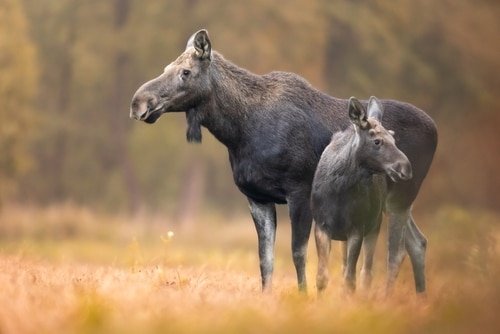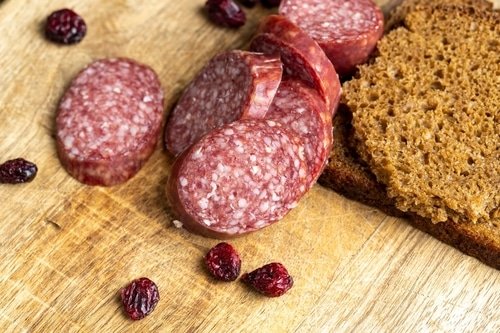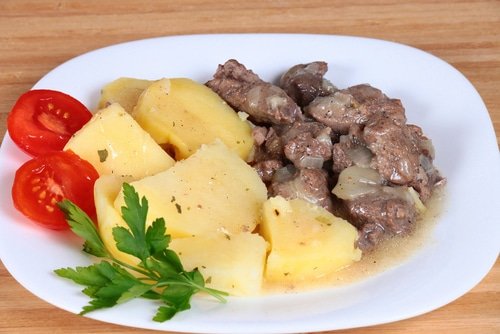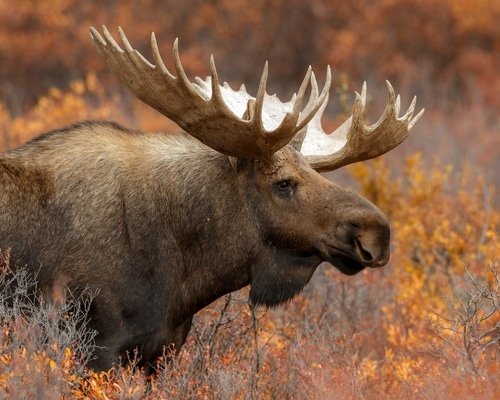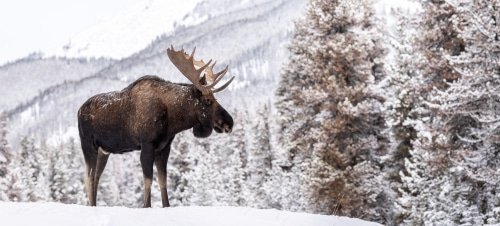When you think of the wilderness, the moose is a magnificent creature that easily comes to mind. These colossal herbivores, with their towering antlers and imposing stature, embody the regal charm of the animal kingdom. Found predominantly in the northern regions of North America and Eurasia, moose stand as living testaments to nature’s grandeur. In this blog, we will discuss moose reproduction.
With their long legs, humped shoulders, and distinctive snouts adorned with a pendulous dewlap, they are instantly recognizable. But beyond their impressive appearance lies an even more fascinating aspect of their existence – reproduction.
The Lifeline of Survival: The Importance of Moose Reproduction
Reproduction is not just an ordinary occurrence in the lives of moose; it is a fundamental aspect that ensures their species’ survival in demanding and ever-changing ecosystems. As with any other living organism, procreation forms an integral part of the intricate tapestry known as the circle of life.
For moose, successful reproduction contributes significantly to maintaining population dynamics and sustaining genetic diversity within their habitats. During the breeding season—usually in late September or early October—a flurry ensues among these gentle giants as they engage in courtship rituals and mate selection processes culminating in copulation.
This magical time marks a critical period where nature’s choreography determines which individuals will produce offspring that carry on the legacy of these majestic creatures. Moose reproduction is not merely a spectacle for onlookers; it plays an essential role in shaping ecosystems.
The arrival of new generations influences predator-prey dynamics by providing sustenance for predatory species such as wolves and bears. Furthermore, through seed dispersal via their droppings while grazing on vegetation, moose contribute to maintaining plant biodiversity across vast landscapes.
As we delve deeper into the enchanting world of moose reproduction, we will explore the intricacies of their captivating mating rituals, the wonders of copulation, and the nurturing care bestowed upon their precious young. Join us on this journey through the mysteries of the moose life cycle, where passion and perseverance intertwine to ensure the continuation of these extraordinary creatures.
Moose Mating Season: The Rut
The Annual Dance of Love
Ah, the magnificent moose! When it comes to romance, these majestic creatures don’t mess around. The breeding season of moose, commonly known as “the rut,” is a time of excitement and transformation.
Like clockwork, this ritual occurs in late summer or early fall, typically from September to October, when the air carries a hint of crispness. This is when male and female moose experience remarkable physical changes and embark on their quest for love.
Timing and Duration of the Rut
To truly appreciate the grandeur of the rut, one must first understand its timing. As the days grow shorter and temperatures drop, male moose emerge from their secluded hideaways with a newfound vigor.
They prepare themselves for battle in pursuit of potential mates. The length of this breeding season can vary slightly depending on geographical location and environmental factors.
In northern regions, with harsher winters, the rut tends to occur earlier than in southern regions. However, on average, you can expect this captivating spectacle to last anywhere from two to four weeks.
Physical Changes in Male and Female Moose During this Period
When it’s time for amour amongst moose-kind, both males (bulls) and females (cows) undergo notable physical transformations that make them irresistible to each other – or at least that’s what they hope! As if Mother Nature herself has lent her artistic handiwork to these creatures, male moose experience a metamorphosis that would make any sculptor envious. Their antlers grow substantially larger during this period – an impressive display intended to woo potential mates while intimidating rival suitors.
On the other side of romance’s coin is the female moose, whose changes are less visible but just as vital for continuing the moose life cycle. The cows’ reproductive organs prepare for potential fertilization, and their behavior shifts as they become more receptive to the advances of eager bulls.
Additionally, female moose emits chemical signals known as pheromones – an aromatic love potion that entices and guides potential mates toward them. So, with their antlers held high, and pheromones in the air, male and female moose embark on this annual dance of love during the rut, making this a truly magical time in the lives of these incredible creatures.
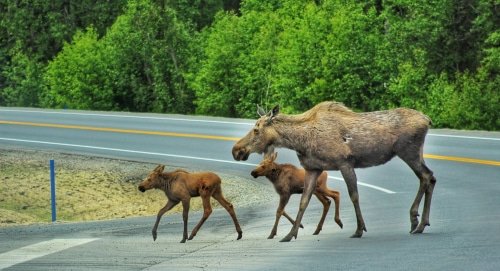
Moose Courtship Rituals
Male moose (bulls) competing for dominance
During the breeding season of moose, known as the rut, male moose engage in fierce battles to establish dominance and secure the opportunity to mate with receptive females. These battles can be intense, with bulls using their massive antlers as weapons to assert their dominance. The size and shape of a bull’s antlers play a crucial role in determining its status within the hierarchy.
The bigger and more impressive the antlers, the higher their chances of dominance. It’s like a moose version of a heavyweight boxing match, with bulls jockeying for position and engaging in epic clashes.
Antler size and its role in establishing a hierarchy
Antlers are not just showy ornaments for male moose—it’s all about establishing dominance! Antlers’ impressive size and complexity are indicators of a bull’s age, health, and genetic fitness. The larger an individual’s antlers are, the higher its chances of securing a prime spot within the social pecking order.
Dominant bulls with massive antlers intimidate their rivals by displaying their strength during mating season. It’s like nature’s saying, “I’m big and powerful – back off!” By possessing larger antlers, bulls gain an advantage when competing for access to receptive cows.
Vocalizations and displays to attract females
If you thought male moose were all about brute strength alone – think again! These majestic creatures have an arsenal of vocalizations and displays to charm female counterparts during courtship rituals. Bulls produce deep guttural grunts that resonate through the forest during the breeding season, serving as territorial calls that signal both readiness for mating and a challenge to other males.
Additionally, they engage in elaborate displays such as thrashing vegetation with their antlers, splashing water, and even urinating on themselves to create a pungent odor that attracts females. It’s like a moose version of a romantic dance-off, where each bull tries to outperform the others in wooing potential mates with their showmanship and vocal prowess.
The Mating Behavior of Moose
A Dance of Attraction: Female Moose (Cows) Selecting a Mate
In the enchanting realm of moose romance, the female moose, affectionately known as cows, hold the reins when it comes to choosing their mates. During moose breeding season, also known as the rut, the cows observe and evaluate potential suitors with meticulous precision. They pay close attention to one key aspect: male displays.
These captivating displays combine impressive antler displays, vigorous movements, and vocalizations that resonate through the forest. The cows are particularly drawn to males who exhibit dominance and confidence in their displays.
Antlers play a significant role in establishing a hierarchy among males during this contest for affection. The size and complexity of these majestic headgear can be awe-inspiring; they reflect years of growth and indicate strength and genetic fitness.
The Power of Scent: The Role of Pheromones in Female Mate Choice
While male displays capture the attention of female moose during their search for a suitable partner, there’s an invisible force at play that influences their decision-making – pheromones. Pheromones are chemical compounds released by animals to communicate with others of their species.
In the case of moose courtship, pheromones emitted by males have a significant impact on female mate choice. These scent signals provide essential information about a male’s genetic compatibility and health status.
As potential mates waft these chemicals through the air during encounters, females pick up on subtle variations that allow them to assess which suitor possesses desirable genetic traits for producing healthy offspring. The intricate interplay between male displays and pheromones creates an enchanting dance between courtship rituals and olfactory cues, elevating moose romance to a captivating spectacle in the vast tapestry of the moose life cycle.
The Act of Mating: Copulation Process
Challenges Faced by Bulls During Mating
When it comes to moose, mating can be quite an endeavor, especially for the bulls. One of the major challenges they face is the difficulty in mounting their female counterparts due to their massive size. Imagine being a gigantic moose with impressive antlers trying to navigate this delicate task. It’s no easy feat!
Difficulty in Mounting due to their Massive Size
Male moose, or bulls, are known for their imposing stature and powerful build. These magnificent creatures can stand as tall as six feet at the shoulder and weigh over 1,000 pounds!
With such size and weight, attempting to mount a female moose during mating season becomes challenging. Bulls have to maneuver carefully to ensure successful copulation without causing harm or discomfort to themselves or their mates.
Adaptations like Specialized Hooves for Better Grip
Nature has equipped moose with fascinating adaptations that assist them during mating. One such adaptation is their specialized hooves that give them a better grip while mounting females.
Moose hooves are broad and flat, like snowshoes in deep snow and muddy terrain. These hooves are crucial in maintaining balance and stability during copulation, reducing the chances of slipping or losing control.
During moose breeding season, these adaptations become vital for successful reproduction. Despite the challenges bulls face due to their massive size, nature’s ingenious design allows them to perform this essential task efficiently while ensuring minimal risk or inconvenience for both partners involved in this magical dance of life.
Pregnancy and Gestation Period
Fertilization, implantation, and embryonic development: Once a female moose (cow) has successfully mated during the rut, the fertilized egg undergoes implantation. This occurs when the fertilized egg attaches itself to the uterine wall of the cow. From there, embryonic development begins to take place.
The zygote gradually develops into an embryo, with various organs and body systems beginning to form. This remarkable process sets the stage for new life within the moose population.
Length of gestation period (approximately eight months): The gestation period for moose lasts around eight months, which is relatively long compared to other mammals. During this time, the cow carries her developing calf inside her womb.
It’s important to note that gestation periods can vary slightly between individual moose and geographic regions due to climate and available resources. However, on average, these magnificent creatures carry their young for approximately 240 days before giving birth in what is known as the calving season.
Throughout the pregnancy and gestation period of a moose, significant physiological changes occur within both mother and calf that play crucial roles in ensuring a successful birth and subsequent survival. Understanding these processes sheds light on the wonders of nature’s intricate mechanisms sustaining moose populations over generations.

